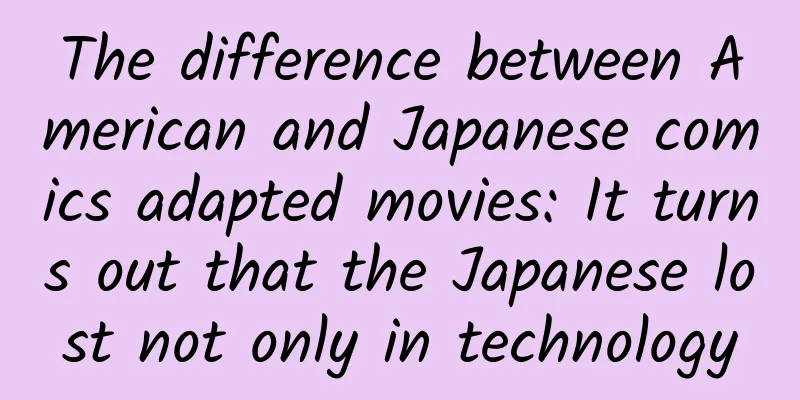The difference between American and Japanese comics adapted movies: It turns out that the Japanese lost not only in technology

|
Each period of time has a special popular trend, and for the ACG industry, this year has become the first year of comic-adapted movies. A total of 40 comic-adapted movies from American and Japanese comics have been released this year, an unimaginable number. However, there is still a big gap between Japanese comic-based movies and American comic-based movies. The latter have a large market, a wide audience, and high box office, while the former are obviously limited by the number of fans of the original work. Although Japan is the largest exporter of comics, the United States is also an important market for them and is very successful. But why do Japanese comic-based movies not have as much box office appeal as American comic-based movies? Japanese comics tend to be realistic American comics are more realistic in style and character design, so they don't feel out of place when adapted into live-action movies. Japanese comics have too many cute and exaggerated plots and characters, which makes it difficult to express them in live-action movies, so it makes people feel weird or even funny, which makes the audience feel out of place. Japanese and American comics producers are all trying to make the characters in the comics more relevant to the real world and make them more realistic, but their strategies are very different. Japanese comic writers often have wild imaginations and are good at setting up completely imaginary worldviews in order to gain more room for imagination in the story. For example, in Dragon Ball, humans and animals are both highly intelligent creatures; in Attack on Titan, humans are forced to live behind high walls by giants; in Naruto, ninjas lead the world, etc., all of these are the same routine. At the same time, to make the characters in comics believable, it is often necessary to add more exaggerated characteristics to the characters and deepen their images. For example, Luffy's image of a naive CEO, Zoro's attribute of being a road idiot, Naruto's obsession with ramen, etc. By portraying and strengthening certain character characteristics or preferences, they are deeply imprinted in our minds, thus breaking the dimensional wall and enhancing the credibility of the story. However, this also leads to the characters and stories in Japanese comics being exaggerated and crazy, full of a middle school atmosphere, which runs counter to the usual form of movies. The main strategy of American comics is not to bring the second dimension into reality, but to build the second dimension on the basis of the real world view. The original setting background of many superheroes is our real world, which is why Captain America, Iron Man, Spider-Man and other comic heroes all live in New York. This also promotes the possibility of horizontal creation between works. Moreover, unlike the setting of Japanese comics that "the protagonist of this world can fly", the superheroes in American comics basically follow the laws of geophysics, and their superpowers mostly come from some cutting-edge technologies that are real or slightly "deduced". As the saying goes, "the rich rely on technology, the poor rely on mutations". This more realistic and down-to-earth approach allows American adapted films to better absorb the advantages of genre films, incorporate more popular elements from the real world, and dilute the surreal colors in the original works. Even first-time audiences can accept the characters and story settings in the film without any obstacles. This is also a solid foundation for the healthy development of American comic-adapted film series. Comic-book movies cannot do without special effects The above factors do exist, but they are more about the difference in comic forms, and it is hard to say whether they are right or wrong. The main reason for the failure of Japanese comic-adapted movies is that the special effects technology of the movies is too expensive. The popular Japanese comics are often boys' comics. It is very difficult to adapt comics such as "Dragon Ball", "One Piece", "Naruto", and "Attack on Titan", which are seriously constrained by the special effects of the movies. For example, the live-action version of "Attack on Titan" cannot be called a movie special effect at all, but a special effects movie. On the contrary, some Japanese comic-adapted movies with daily life, youth romance, history, and mystery themes have been successful, such as the early "Honey and Clover" and the recent "Rurouni Kenshin", "Midnight Diner", "Solitary Gourmet", etc. Therefore, the poor performance of Japanese comic-adapted movies cannot be simply attributed to the plot and character design. Generally, popular youth hot-blooded comics have grand scenes and imaginative content. To perfectly express them, sufficient special effects technology is required, and this is the weakness of Japanese movies. You may say that Japan has first-class CG technology, so how can it be that movie special effects are not good? It is true that Japanese CG animation has first-class production capabilities with the development of Japanese games at that time, but CG animation is not movie special effects. The technical difficulty of movie CG special effects lies in the synthesis of pictures. It is extremely difficult to synthesize the virtual pictures of the CG part with the real pictures, and ensure that the perspective, lighting, picture motion matching and many other aspects are consistent. The most senior position in a movie special effects company is generally held by a CG synthesizer, not a CG animator. It is obvious which is more important. Most of the top special effects teams with this technology are gathered in Hollywood. They master CG, film photography, physical effects, green screen technology, fluid simulation, motion capture, particles, screen synchronization control, lighting HDR, rendering and many other technologies. These technologies are crucial for movie special effects. In this regard, American film companies undoubtedly have the upper hand. Not only Japanese, but also global film production companies have to ask American special effects teams to create credible and realistic movie special effects scenes. The size of the market determines the quality of film special effects technology The problem with movie special effects is actually a problem of funding, and funding is restricted by the size of the movie market. Although Japan, as a developed country, has been the world's second largest economy for 42 years, its movie market is not that large due to its domestic population base. From 198.16 billion yen in 2005 to 217.19 billion yen in 2015, it can be seen that the Japanese movie market has almost stagnated in the past ten years. This also proves that the Japanese movie market is becoming saturated and urgently needs to open up new markets. However, Japanese films are too localized, with a single narrative method, and the core of Japanese films is not in harmony with the global mainstream values (this is also the case in China), which has led to Japanese local films never being recognized by the global film market. From beginning to end, there has been only one recognized director, Akira Kurosawa. These reasons have led to the lack of real big-budget films in Japan, and it is not good at big-budget productions. It only relies on Japanese-style small fresh films and animations, which have some fans in small circles in East Asia. From the Japanese market, judging from this year's box office list, the top ten are almost all local films, which proves that the Japanese film market has produced the "Galapagos Islands effect". That is, when the development of an island country is extremely unbalanced with the outside world, the island country will develop its own unique culture and cognition, and become exclusive. This phenomenon is particularly prominent in the Japanese cultural industry. For example, the poster of Avengers 2 when it was released in Japan has the same style as Before Sunrise! Can you tell it is a sci-fi action movie? Of course, this is not the fault of the importer, I believe it is just the result of following the market. From this perspective, American films are successful. The American film market can be equated with the global film market. The standards for commercial blockbusters are set by Hollywood, which operates on the principle of high input and high output, and creates a streamlined commercial blockbuster model by hiring well-known directors, screenwriters, actors, and using high-tech special effects technology. The investment cost of a movie of hundreds of millions of dollars is very scary, but because the American film industry is the most mature film business model in the world, the mainstream values it outputs are accepted by the whole world. Under the mature cost-income expectation calculation, the cost is as high as hundreds of millions of dollars, and the comic-based movie with special effects can also make a lot of money. Japanese comic-based movies, which are operated in a small circle of East Asian fans, are bound to be difficult to popularize due to risk control, small investment, crude production, and inconsistent character images and worldviews. In recent years, American comic-based movies have been making a lot of money in the market, which has indeed touched the minds of many film companies. The American comics being brought to the big screen have also made Japanese comic fans full of expectations for the live-action adaptation of Japanese comics. But here I have to pour a basin of cold water on you. Don't expect to see Japanese comic-based movies with special effects flying all over the sky. This is unrealistic! As a winner of Toutiao's Qingyun Plan and Baijiahao's Bai+ Plan, the 2019 Baidu Digital Author of the Year, the Baijiahao's Most Popular Author in the Technology Field, the 2019 Sogou Technology and Culture Author, and the 2021 Baijiahao Quarterly Influential Creator, he has won many awards, including the 2013 Sohu Best Industry Media Person, the 2015 China New Media Entrepreneurship Competition Beijing Third Place, the 2015 Guangmang Experience Award, the 2015 China New Media Entrepreneurship Competition Finals Third Place, and the 2018 Baidu Dynamic Annual Powerful Celebrity. |
<<: Faraday Future is sued by Fuzhuo for $10 million in overdue payments
>>: Microsoft and TomTom launch smart maps for driverless cars
Recommend
One picture to understand|It turns out that Qu Yuan also celebrated the Dragon Boat Festival
Produced by: Dongdong Miao, WeChat ID: Dongdongme...
How to apply the addiction model in activity design of game products?
Recently, one of the team's stage goals for p...
Excessive calcium supplementation is harmful! Many people have taken calcium supplements incorrectly over the years
Is the TV cabinet of your elderly also piled with...
Lighthouse inheritance | Lu Yuanjiu: The scientific spirit is to work honestly
On June 29, 2021, the "July 1st Medal" ...
8 essential steps for a successful fission campaign!
Poster fission activities are still the most effe...
Don't eat! Don't eat! Don't eat!
Sugarcane is a sweet and juicy fruit Always popul...
From 0 to 1 users, how to do a good job in seed-stage user growth operations?
The product operation cycle is generally divided ...
Sina Fans Promotion Strategy, a must-learn for App operation and promotion personnel!
Someone told me that Sina Weibo’s scale is not up...
How far are traditional TV brands from experiencing the "Nokia tragedy"?
Even though Ma Huateng once publicly promised tha...
Baidu Information Flow White Paper | Three steps to teach you how to use Baidu Information Flow creatively
This one article is worth ten. Mobile application...
Apple app developers are developing new software to avoid the "Apple tax"
Beijing time, October 8, noon news, it is reporte...
8000 words to deconstruct the 618 marketing promotion gameplay
At present, most brands’ 618 is still in the proc...
Do modern people really need to gain weight in autumn? Compared with gaining weight in autumn, what should we do in autumn?
After the Beginning of Autumn, the heat wave grad...
The nine-square grid thinking method of APP in the application market!
The boss is going crazy because there is no promo...
Trump's unexpected election as US president reveals his shady career history
The US presidential election finally came to an e...









